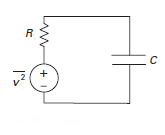Steps
- Derive the value of the square of the voltage on the capacitor
- Assume the noise voltage on the resistor can be faked up and simulated by an equivalent voltage source driving the circuit with a noiseless resistor. The ideal source is assumed to have uniform power spectral density.
- Equate the value of the voltage on the capacitor with that given by Boltzmann's equipartition theorem and try not to get hanged in the mean time.
Equipartition Theorem: Each orthogonal degree of freedom gets 1/2KT of energy. This can be thought of as maximum entropy using uniform distribution over each axis. Look for the quadratic energy terms. With a capacitor all you have is: 


Now the circuit analysis
P.S.D. == Power Spectral Density
PSD(Capacitor Voltage) = PSD(Ideal Voltage Source) * ( Frequency response of the RC circuit ) …….this is in the frequency domain



Total energy on the capacitor is the integral [0,infinity]
 The integral of this is arctan()
The integral of this is arctan()

The value on the left hand side is the previous value we deduced using Boltzmann:


Which yields the relation between noise voltage, bandwidth and resistance.

Research Links
- Wikipedia: Equipartition Theorem
- Equipartition Theorem: Valance
- Several different approaches to deriving the noise relation including the one taken by Nyquist – Nyquist approach includes black body radiation concept.
- A brief history of the events leading up to the discovery of thermal noise

0 Comments